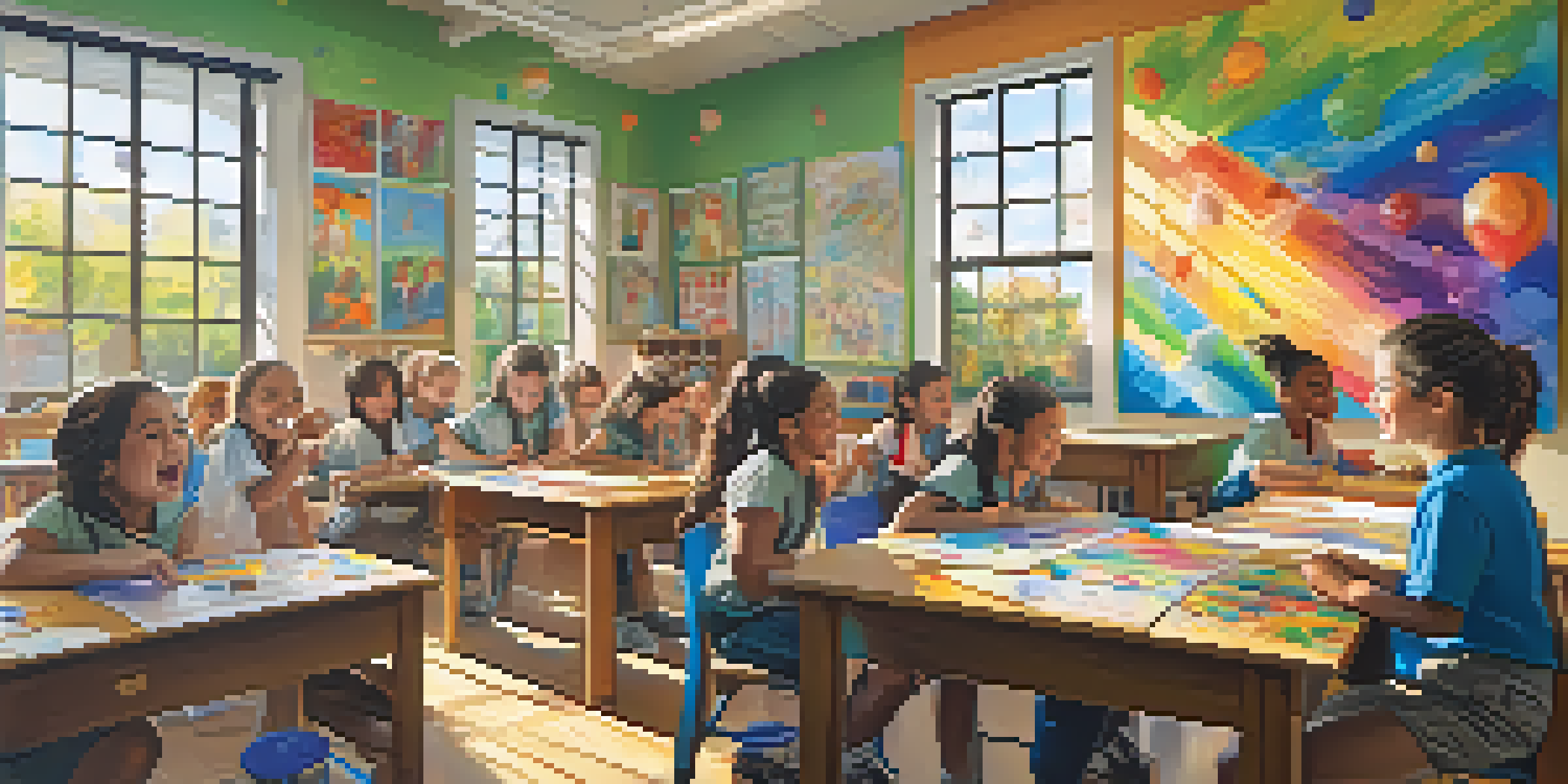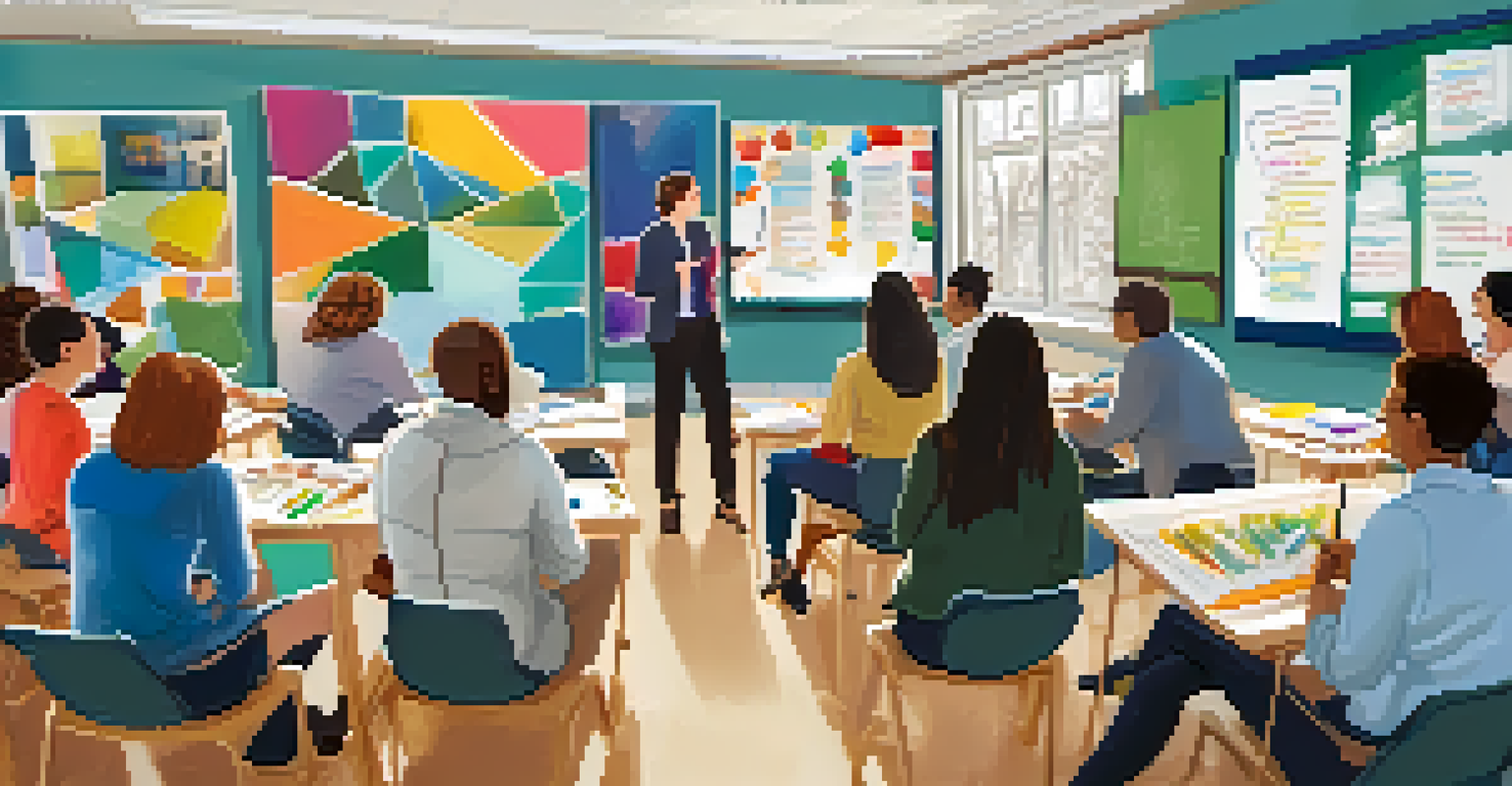Nurturing Creativity: A Path to Teacher Well-Being

Understanding the Link Between Creativity and Well-Being
Creativity isn't just a buzzword; it's a powerful tool that can enhance well-being. For teachers, nurturing creativity can lead to reduced stress and improved job satisfaction. When educators engage in creative activities, they not only stimulate their minds but also find joy in their work, making the classroom environment more inviting.
Creativity is intelligence having fun.
Research shows that creative expression can be a vital outlet for emotions, helping teachers process their experiences. This connection between creativity and emotional health can transform the way educators approach their challenges. By embracing creativity, teachers can cultivate a more positive mindset that directly impacts their performance and relationships with students.
In essence, integrating creativity into daily routines can foster resilience among teachers. It allows them to approach problems with a fresh perspective, ultimately leading to a more fulfilling professional life. This vibrant approach not only benefits teachers but also enriches the educational experience for their students.
The Role of Creativity in Classroom Engagement
When teachers incorporate creative methods into their lessons, they capture students' attention in unique ways. Activities like storytelling, art projects, or even gamified learning can transform a mundane lesson into an interactive experience. This engagement not only excites students but also invigorates teachers, making their work feel more meaningful.

Moreover, creativity encourages collaboration among students, fostering a sense of community in the classroom. Teachers who model creative thinking inspire their students to express themselves freely, leading to a more dynamic learning environment. This mutual engagement not only enhances learning outcomes but also contributes to teachers' well-being by reducing feelings of isolation.
Creativity Boosts Teacher Well-Being
Engaging in creative activities helps educators reduce stress and enhances their job satisfaction.
Ultimately, a creative classroom is a happy classroom. When educators feel excited about the material they teach, their enthusiasm becomes contagious, creating a positive feedback loop. This atmosphere not only enhances student learning but also serves as a vital source of joy for teachers.
Practical Strategies for Fostering Creativity
Fostering creativity doesn’t require grand gestures; small, intentional changes can make a significant impact. Teachers can start by incorporating brainstorming sessions into their planning. These sessions allow educators to explore new ideas and methods, offering fresh perspectives that can rejuvenate their teaching practices.
The best way to predict the future is to create it.
Additionally, setting aside time for personal creative projects can be incredibly beneficial. Whether it's painting, writing, or even gardening, engaging in hobbies allows teachers to recharge and rediscover their passion for creativity. This personal investment can translate into a more energized approach in the classroom.
Lastly, creating a supportive environment for creativity is crucial. Encouraging peer collaboration and sharing among teachers can lead to innovative solutions and inspire new techniques. By building a community that values creativity, educators can enhance their well-being and enrich their teaching.
The Impact of Creative Professional Development
Professional development should be more than just mandatory training; it should inspire and ignite creativity among teachers. Workshops that focus on creative teaching methods can provide educators with practical tools and techniques they can implement in their classrooms. These sessions not only enhance teaching skills but also foster a sense of community and shared purpose.
Engaging in creative professional development can also lead to personal growth. When teachers step out of their comfort zones and explore new ways of thinking, they often find renewed passions and interests. This transformation can significantly contribute to their overall well-being and job satisfaction.
Creative Classrooms Engage Students
Incorporating creative methods in lessons transforms student engagement and fosters a positive learning environment.
Moreover, the collaborative nature of creative professional development can strengthen bonds among educators. Sharing experiences and ideas allows teachers to support one another, creating a nurturing environment that prioritizes well-being. This community aspect is vital, as it helps combat feelings of burnout and isolation.
Building a Culture of Creativity in Schools
For creativity to flourish, it must be woven into the fabric of school culture. School leaders can play a pivotal role by promoting creative initiatives and celebrating innovative practices. By highlighting the importance of creativity, they set a precedent that encourages teachers to embrace new ideas and approaches.
Creating platforms for teachers to share their creative practices can help build this culture. Regular meetings or showcases where educators present their innovative methods can inspire others and foster collaboration. This sharing of ideas not only enhances individual teaching practices but also strengthens the overall educational community.
A school culture that values creativity ultimately leads to happier, more fulfilled teachers. When educators feel supported in their creative endeavors, it translates into a more vibrant and engaging learning environment for students. This cyclical relationship between teacher well-being and student engagement is crucial for overall success.
Overcoming Challenges to Creativity
Despite the benefits, many teachers face barriers to creativity in their roles. Time constraints, curriculum demands, and standardized testing can stifle innovative teaching methods. Acknowledging these challenges is the first step toward finding solutions that allow for creative expression in the classroom.
One effective strategy is to integrate creativity into existing frameworks. Teachers can find ways to infuse creative elements into required curricula, making lessons more engaging without sacrificing essential content. This approach not only meets educational standards but also nurtures a more dynamic learning environment.
Collaboration Enhances Creativity
Building a supportive community among teachers allows for shared resources and innovative solutions to overcome challenges.
Additionally, seeking support from colleagues can help teachers navigate challenges. Collaboration often leads to shared resources and innovative solutions, creating a more supportive atmosphere. When educators work together to overcome obstacles, they foster a culture of creativity that benefits everyone.
The Long-Term Benefits of Nurturing Creativity
The long-term benefits of nurturing creativity in teaching extend far beyond the classroom. Educators who prioritize creativity often experience greater job satisfaction, reduced burnout, and a deeper connection to their profession. This sense of fulfillment can lead to a more sustainable career in education, ultimately benefiting students as well.
Furthermore, fostering creativity in educators can have a ripple effect on students. When teachers model creative thinking, students are encouraged to think critically and innovatively. This skill set is essential in today's rapidly changing world, equipping students for future challenges.

In conclusion, nurturing creativity is not just beneficial for teachers; it's a vital component of a thriving educational environment. By prioritizing creative practices, educators can enhance their well-being while inspiring the next generation of thinkers and creators. It's a win-win situation that ultimately enriches the entire educational experience.